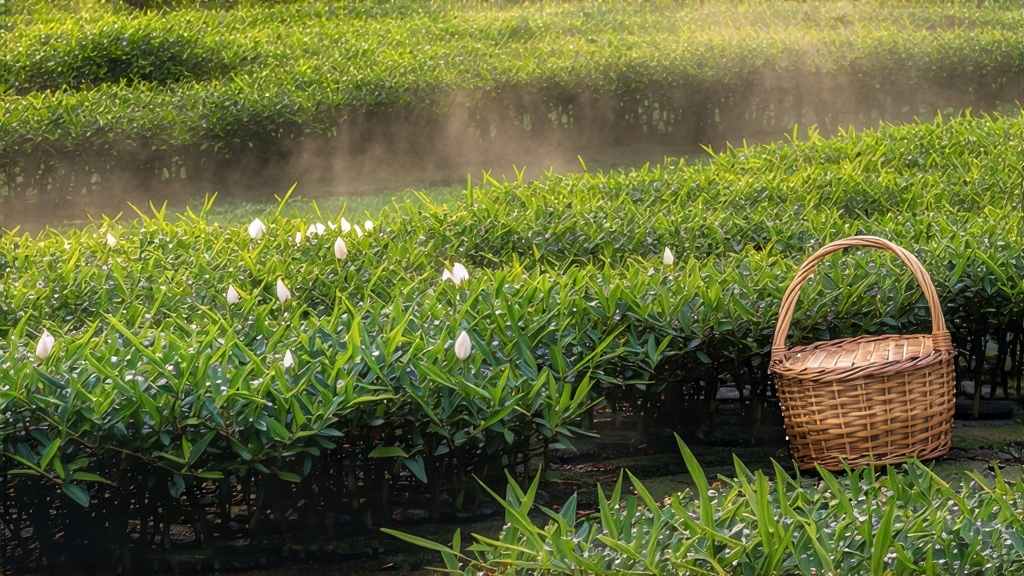
Among the six great families of Chinese tea, white tea is the least assertive yet the most elusive, a quiet poem written in silver down and spring haze. Within this minimalist lineage, Bai Hao Yin Zhen—“Silver Needle”—reigns as the purest expression of leaf and time. To the uninitiated it may look like a pile of pale twigs, but to those who listen with palate and memory it is a distillation of coastal fog, mountain mineral, and the slow patience of Fujian’s March sun.
History: From Imperial Tribute to Global Muse
The first written record of white tea appears in the Song dynasty treatise Da Guan Cha Lun (1107 CE), yet those cakes of compressed white were darker, brooding ancestors of today’s loose-leaf style. Silver Needle itself emerges clearly only during the late Qing, when the market in Fuding and Zhenghe counties shifted from powdered tribute bricks to the elegant, needle-shaped buds demanded by wealthy tea merchants in Canton and, soon after, by European salons enchanted by anything that glimmered like precious metal. Legend claims that only virginal girls wearing cotton gloves were allowed to pluck the buds at dawn, dropping them into wicker baskets lined with silk so the sun would not bruise the virgin down. While the detail is surely romantic embroidery, it signals the cultural value placed on pristine handling—an ethos still alive in every modern tea garden that stakes its reputation on Silver Needle.
Terroir: Where Ocean Meets Mountain
Authentic Bai Hao Yin Zhen is born in two micro-regions of northern Fujian: Fuding, brushed by the East China Sea’s humid breath, and Zhenghe, slightly higher and cooler in the Wuyi foothills. In Fuding the indigenous Da Bai Hao (“Big White Down”) cultivar develops extraordinarily plump buds, their ivory jackets densely packed with trichomes that will later lend the liquor its shimmering sweetness. Zhenghe’s Xiao Bai (“Small White”) bushes yield slimmer needles but a deeper, more floral fragrance thanks to cooler nights and iron-rich lateritic soil. Both areas share a maritime monsoon rhythm: March mornings wrapped in fog that burns off by ten o’clock, followed by a brisk afternoon breeze. This diurnal seesaw is critical; it allows the buds to wither slowly without fermenting, concentrating amino acids while preserving the delicate catechin structure that gives white tea its antioxidant fame.
Plucking: One Bud to Rule Them All
The picking window is cruelly short—usually ten days between Qingming and Grain Rain when the buds are still closed “like sparrow’s tongues” and measure 1.5–2.5 cm. Experienced pickers work counter-clockwise around each bush, snapping the stem just above the first scale leaf using thumb and middle finger in a single flick that avoids bruising. A full kilogram of finished Silver Needle requires roughly thirty thousand buds, all picked before lunch because afternoon sap rise increases bitterness. The baskets are never piled higher than five centimeters; excessive weight would crush the hairs and initiate premature oxidation.
Craft: The Art of Doing Almost Nothing
If green tea is a flash sauté and black tea a long braise, white tea is sashimi—its greatness hinges on what is withheld. Once transported to the hacienda-style factory, the buds are laid in whisper-thin layers on bamboo trays stacked inside sun-warmed corridors with latticed walls. For forty-eight to sixty hours they rest, exhaling grassy moisture while inhaling the scent of mountain orchids drifting through the slats. The master witherer’s job is to read the weather like a sailor: if humidity spikes above 70 %, he lowers the trays; if the sun grows too fierce, he wheels them into shade. No rolling, no pan-firing, no charcoal roasting—only a final gentle bake at 40–45 °C to reduce moisture to 5 %, locking in the silver shimmer. The result is a tea that is 100 % bud, its surface frosted like winter’s first hoarfrost, its spine slightly curved like a calligrapher’s finest stroke.
Chemistry in Suspension
Laboratory chromatograms reveal why Silver Needle tastes almost aqueous yet lingers for minutes: the bud’s apical cells contain up to 4.2 % theanine, triple that of mature leaves, providing brothy umami. Caffeine hovers around 3.5 %, comparable to Assam, but the absence of roasting means chlorophyll and volatile terpenes remain intact, translating